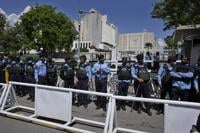After three weeks of fighting, Russia is still struggling to dislodge Ukrainian forces from the Kursk region, a surprisingly slow and low-key response to the first occupation of its territory since World War II.
It all comes down to Russian manpower and Russian priorities.
With the bulk of its military pressing , the Kremlin appears to lack enough reserves for now to drive out Kyiv's forces.
doesn’t seem to view the attack — or at least, give the impression that he views it — as a grave enough threat to warrant pulling troops from eastern Ukraine's Donbas region, his
“Putin’s focus is on the collapse of the Ukrainian state, which he believes will automatically render any territorial control irrelevant,” wrote Tatiana Stanovaya, senior fellow at the Carnegie Russia Eurasia Center.
Putin's priorities
Months after launching in 2022, Putin illegally annexed the Ukrainian regions of Donetsk, Luhansk, Zaporizhzhia and Kherson as part of Russian territory, and their full capture has been a top priority. He declared in June that Kyiv must withdraw its forces from parts of those regions it controls as a condition for peace talks, a demand that Ukraine rejects.
“In marshaling forces to meet Ukraine’s incursion, Russia is doing all it can to avoid drawing units from its own offensive in the Donbas,” said Nigel Gould-Davies of the International Institute of Strategic Studies. “Russia currently judges that it can contain the threat on its own soil without compromising its most important goal in Ukraine."
Even as Ukrainian forces pushed into Kursk on Aug. 6, Russian troops continued their slow advance around the strategic city of and other parts of the Donetsk area.
“Russia is very keen on continuing the attacks toward Pokrovsk and not taking resources away from Pokrovsk to Kursk,” said Nico Lange, senior fellow at the Washington-based Center for European Policy Analysis.
Unlike Pokrovsk, where Ukrainian forces have built extensive fortifications, other parts of Donetsk still under Ukrainian control are less protected and could be significantly more vulnerable to the Russian onslaught if Pokrovsk falls.
Speaking about Kursk in televised meetings with officials, Putin described the incursion as an attempt by Kyiv to slow the Russian campaign in Donetsk, where he said the Russian advance only has accelerated despite events in Kursk.
Russia also has launched a steady barrage of long-range strikes on Ukraine's power grid. An attack Monday on energy facilities was one of the largest of the war, involving over 200 missiles and drones and causing widespread blackouts. It highlighted loopholes in Ukraine’s air defenses that are stretched between protecting front-line troops as well as infrastructure.
Playing down the incursion
Focused on capturing Ukraine's four regions, Putin has sought to attach little importance to Kyiv's foray into Kursk.
“Rather than rallying the population against a threat to the motherland, the Kremlin is anxious to downplay the incursion,” said Gould-Davies of the London-based IISS.
Faced with the reality of the occupation of Russia’s territory, the state propaganda machine has sought to distract attention from the obvious military failure by focusing on government efforts to help over 130,000 residents displaced from their homes.
State-controlled media cast the attack on Kursk as evidence of Kyiv’s aggressive intentions and more proof that Russia was justified in invading Ukraine on Feb. 24, 2022.
Stanovaya noted that while many Kursk residents could be angry at the Kremlin, the overall nationwide sentiment could actually favor the authorities.
“While it’s certainly a blow to the Kremlin’s reputation, it is unlikely to spark a significant rise in social or political discontent among the population,” she said. “The Ukrainian attack might actually lead to a rallying around the flag and a rise in anti-Ukrainian and anti-Western sentiments.”
A limited Kremlin response
Ukrainian President Volodymyr Zelenskyy has said the push into the Kursk region is meant to create a buffer zone to impede Russian attacks. His chief military officer, Gen. Oleksandr Syrskyi, said Kyiv's forces control nearly 1,300 square kilometers (about 500 square miles) and about 100 settlements in the region, a claim that couldn’t be independently verified.
With the combat situation in Kursk in flux, unlike the static front lines in Donetsk, Ukrainian units could roam the region without establishing a lasting presence in many of the settlements they claim.
Observers say Russia does not have enough well-coordinated resources to chase the Ukrainian forces in Kursk.
“Moscow’s efforts to counter the new Ukrainian offensive appear limited to sending units from all over Russia, including a proportion of militia and irregular forces,” said Ben Barry, senior fellow for land warfare at the IISS, in a commentary.
Until the Kursk incursion, Putin has refrained from using conscripts in the war to avoid a public backlash. Young conscripts drafted for a compulsory one-year tour of duty have served away from the front, and those deployed to protect the border in the Kursk region became easy prey for Ukraine’s battle-hardened mechanized infantry units. Hundreds were captured, and 115 were exchanged for Ukrainian troops over the weekend.
Commentators observed that Putin also is reluctant to call up more reservists, fearing domestic destabilization like what happened when he ordered a highly unpopular mobilization of 300,000 in response to a Ukrainian counteroffensive in 2022. Hundreds of thousands fled Russia to avoid being sent to combat.
Since then, the Kremlin has bolstered its forces in Ukraine with volunteers attracted by relatively high wages, but that flow has ebbed in recent months.
It would take tens of thousands of troops to fully dislodge the Ukrainian force, estimated at 10,000, that used the region’s dense forests as cover.
Clearly lacking resources for such a massive operation, Russia for now has focused on stemming deeper Ukrainian advances by sealing roads and targeting Kyiv’s reserves — tactics that have been partially successful.
Ukraine, meanwhile, has confounded the Russian military by destroying bridges across the Seym River, disrupting logistics for some Russian units in the region and creating conditions for establishing a pocket of control.
Lange predicted Ukrainian troops could use the river to carve out a buffer zone.
“I would expect the Ukrainians to find some few more choke points for Russian logistics and infrastructure, not necessarily only bridges, and take them under control,” he said.
The risks for Ukraine
By capturing a chunk of Russian territory, Ukraine has embarrassed the Kremlin and reshaped the battlefield. But diverting some of the country's most capable forces from the east is a gamble for Kyiv.
“This all carries considerable risk, particularly if an effort to over-stretch Russian forces results in overstretching the smaller Ukrainian forces,” according to Barry of the IISS.
An attempt to create a foothold in Kursk would further extend the more than 1,000-kilometer (over 600-mile) front line, adding to the challenges faced by the undermanned and outgunned Ukrainian forces. Defending positions inside Russia would raise serious logistical problems, with the extended supply lines becoming easy targets.
“The Russian system is very hierarchical and stiff, so it always takes them a significant amount of time to adapt to a new situation," Lange said, "but we will have to see how Ukraine can sustain there, once Russia has adapted and comes with full force.”
___
See full AP coverage at










































